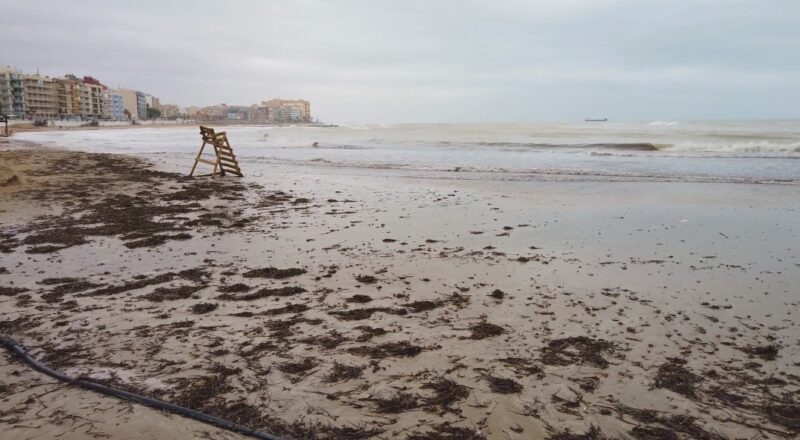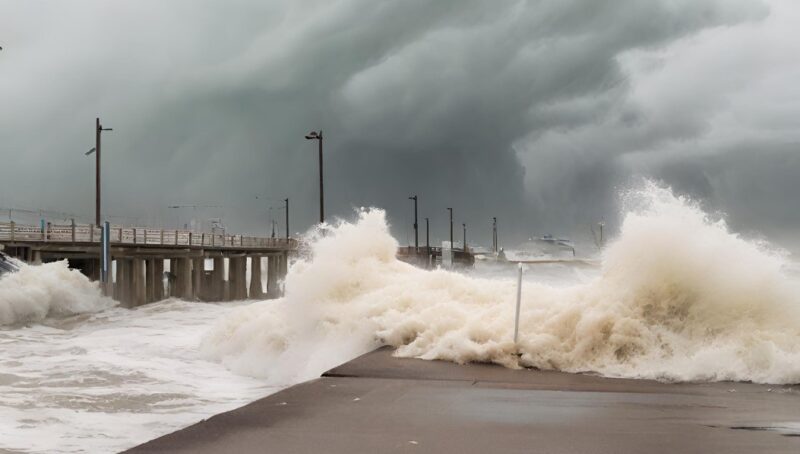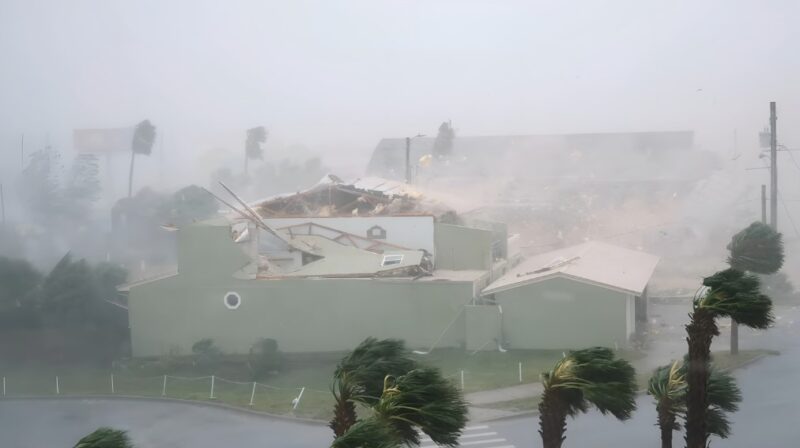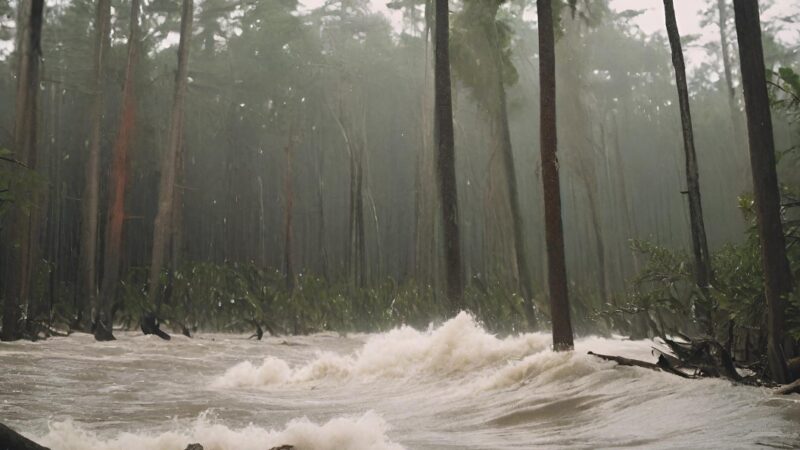A storm surge warning represents a critical alert concerning the potential for life-threatening inundation from rising waters moving inland from the coastline during a severe weather event such as a tropical, subtropical, or post-tropical cyclone.
This warning predicts that such conditions are possible generally within 36 hours, urging immediate attention and action to protect life and property.
Key Takeaways
- A storm surge warning alerts to the risk of life-threatening coastal flooding.
- It indicates that protective actions should be taken due to imminent conditions.
- Recognizing warnings is crucial for effective preparation and safety measures.
Physical Dynamics

Storm surges are abnormal rises of water generated by a storm, occurring over and above the predicted astronomical tides. They are primarily caused by the strong winds of a storm that push water towards the shore, which can combine with the normal tides to create a surge in water level.
The physical dynamics of a storm surge involve complex interactions between the ocean and atmosphere. Factors such as wind speed, storm trajectory, shoreline geometry, and sea floor topography can all influence the magnitude of the surge. Additionally, the surge’s impact can be exacerbated when it coincides with normal high tides, leading to higher and more dangerous water levels.
Storm Surge Warning System
Storm surge warnings are critical components of coastal emergency preparedness, signaling the imminent threat of water rising and moving inland from the shoreline due to a tropical, subtropical, or post-tropical cyclone.
Criteria for Issuance
You should be aware that a storm surge warning is typically issued when there is a danger of life-threatening inundation within 36 hours. This warning suggests that immediate action is required to protect life and property. The issuance depends on various factors such as predicted water levels, the path of the storm, and the vulnerability of coastal areas. For precise criteria, the National Hurricane Center provides a detailed explanation.
Communication Channels
When a storm surge warning is issued, it will be communicated across various channels for broad dissemination. You might receive alerts via television, radio, and wireless emergency alerts. In addition, local authorities might utilize sirens, social media platforms, and text messages to ensure you are informed promptly. Government agencies like FEMA are also involved in the distribution of these critical alerts, aiming to reach as many individuals and communities as possible.
Impacts

Storm surges represent a significant hazard to coastal areas, often leading to destructive impacts on communities and maritime activities. By understanding these effects, you can better appreciate the seriousness of storm surge warnings.
Coastal Communities
Storm surges can have catastrophic effects on coastal communities, with the most immediate impact being inundation. This can result in extensive property damage, not only to homes and businesses but also to vital infrastructure such as roads, bridges, and utility systems. For example, a storm surge warning indicates the risk of life-threatening water moving inland. The depth of water from storm surges can rise quickly, overwhelming local flood defenses. Safety is a major concern since surges can trap people in their homes or cut off evacuation routes.
- Buildings may be flooded, severely damaged, or even destroyed.
- Water, electricity, and communication networks may be disrupted or completely knocked out.
Maritime Activities

For maritime activities, a storm surge can be just as devastating. Ports and harbors may experience severe flooding, leading to economic disruptions due to halted shipping operations and damage to ships and cargo. Aquaculture, such as fisheries, can be impacted by the sudden change in salinity and water temperatures. Recreational activities on the water are also at risk during storm surges, with potential for loss of life and property.
- Storm surges can cause temporary but significant halts in shipping and trade.
- Boats, marinas, and harbor facilities may be submerged, smashed, or swept away.
Preparation and Safety Measures
When a Storm Surge Warning is issued, it’s crucial for you to prioritize immediate preparation and adopt rigorous safety measures. This involves having a clear evacuation plan and a well-prepared emergency kit.
Evacuation Plans
Develop a Household Evacuation Plan:
- Identify a safe area to relocate to if an evacuation is ordered. Check local guidelines for evacuation routes and destinations.
- Arrange a family emergency communication plan. Designate a contact out of the storm surge area as your point of communication.
Emergency Kits and Supplies

Assemble an Emergency Kit:
- Stock adequate water and non-perishable food for each person for at least three days.
- Include a first-aid kit, prescription medicines, personal hygiene items, and a battery-operated or hand-crank radio for updates.
Important Documents and Supplies:
- Gather and protect critical documents such as insurance papers, medical records, bank account numbers, and a list of contact information.
- Prepare a portable kit in case you need to evacuate quickly, ensuring you include cash and charging devices for mobile phones.
Historical Significance

Understanding storm surge warnings is crucial as they signify the potential of life-threatening inundation from rising waters during a storm event. These warnings have been developed through the lessons learned from past catastrophic events.
Noteworthy Storm Surge Events
- Galveston Hurricane (1900): This hurricane caused a storm surge of 15 feet, leading to over 6,000 deaths. It remains the deadliest natural disaster in United States history.
- Hurricane Katrina (2005): Producing a surge of 25-28 feet along portions of the Mississippi coast, Katrina exemplified the destructive power of storm surges, contributing to severe damage and loss of life.
FAQs
What causes a storm surge during a hurricane?
A storm surge is caused by the intense winds of a hurricane pushing water onshore, leading to abnormally high water levels. The severity of this surge depends on the hurricane’s wind speed, the shape of the coastline, and the ocean floor’s slope.
How can one identify the warning signs of a potential storm surge?
You can identify warning signs of a potential storm surge by staying informed through emergency alerts from local authorities and weather forecasts that indicate risks of high winds and rising water levels.
What are the typical effects of a storm surge on coastal areas?
Storm surges can cause life-threatening inundation, leading to extensive flooding, property damage, and disruption in coastal areas, with low-lying regions being particularly vulnerable.
How does a watch differ from a storm surge warning?
A storm surge watch means a possible of life-threatening inundation, typically issued 48 hours before the anticipated event, while a storm surge warning signifies that inundation is expected within 36 hours.
In the case of it, how long do the effects typically last?
The duration of a storm surge’s effects can vary, depending on the storm’s speed and size, but it generally lasts from several hours to a couple of days as the storm passes through the area.
How far inland are the impacts of a storm surge felt?
The impacts of a storm surge can be felt far inland, potentially affecting areas beyond immediate coastal regions, with the exact distance depending on the storm’s intensity and the area’s topography and geographic features..
Conclusion
Storm surge warnings are essential alerts that signal the potential for life-threatening coastal flooding due to rising waters from severe weather events.
Understanding the dynamics of storm surges, recognizing warning signs, and taking immediate protective actions are crucial for the safety of life and property.
The historical significance of storm surges in past catastrophic events underscores the importance of preparedness and adherence to safety measures. By staying informed and ready, individuals in coastal areas can mitigate the impacts of these powerful natural phenomena.
